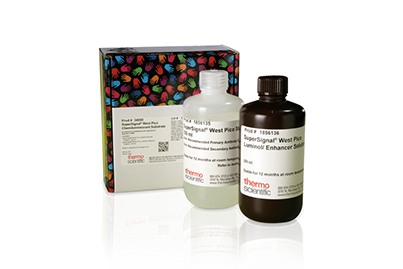As with other components in a western blotting system, there are many chemiluminescent substrate choices available. The appropriate selection of a substrate depends on the detection level (sensitivity) required, the target protein's abundance, and the sample's availability.
- Excellent sensitivity—five substrates providing picogram- to femtogram-level sensitivity
- Strong light emission—longer signal duration allows for multiple exposures
- High intensity—signal is twice as intense as in other luminescence-based systems
- Antibody savings—our substrates are optimized to work with more dilute primary and secondary antibodies
Select the optimal chemiluminescent substrate for your western blot application from our five substrates.
Chemiluminescent substrates
Choose the appropriate chemiluminescent substrate for western blot detection

For data above: STAT3 detection in HeLa cell lysate (lane 1: 20 μg total protein; lanes 2–6: two-fold serially diluted) was performed using Thermo Scientific HRP chemiluminescent substrates. The blots were developed using Invitrogen Anti-STAT3 Antibody (Cat. No. MA1-13042) and Goat Anti-Mouse IgG Secondary Antibody, HRP conjugate (Cat. No. 31430). Images were captured using the Thermo Scientific myECL Imager (Cat. No. 62236).